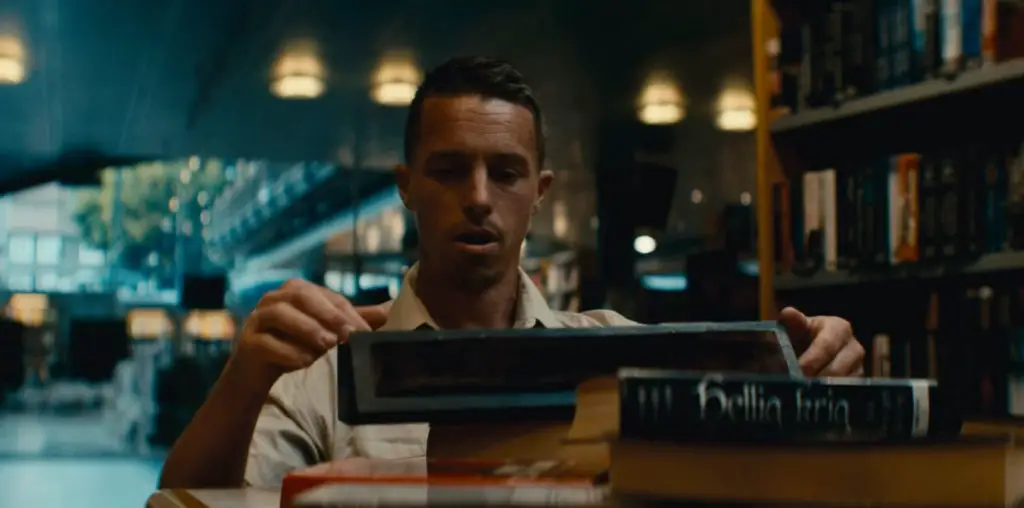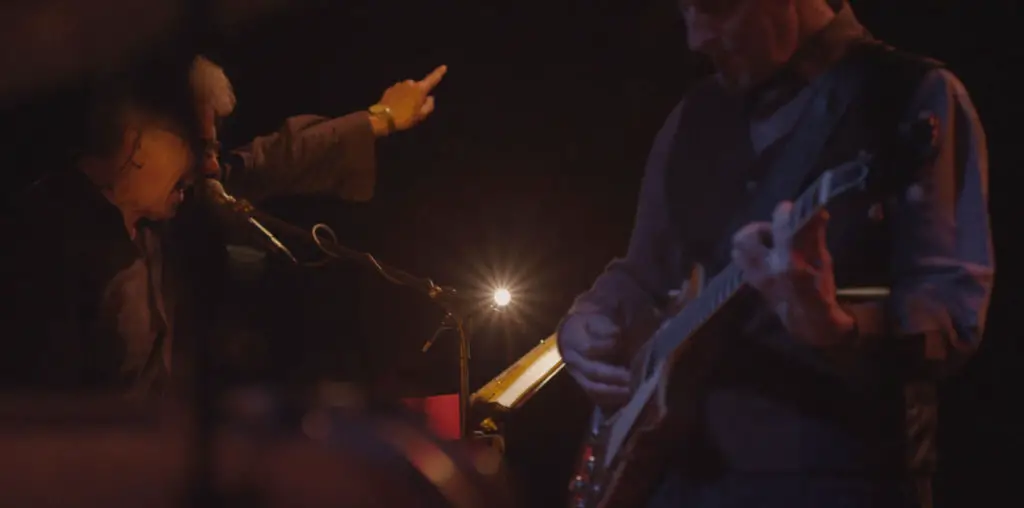
“High Ground” is an emotional metronome of a film, swaying between the horror of combat and the staggering beauty of high-altitude vistas. We meet 11 U.S. veterans of Iraq and Afghanistan, bonded together as participants of a 2010 mountain expedition dubbed “Soldiers to the Summit.” During its ascent of a 20,000-foot Himalayan Peak, the group hauls both backpacks and the considerably heavier baggage of downrange deployment. Participants offer vivid recollections of limbs, vision, and sanity lost via IED blasts, helicopter blades, and rocket-propelled grenades.
It’s sobering, horrifying stuff. Soldiers from “High Ground” provide astonishingly raw perspectives on how war has, literally, fried and disconnected the psychological circuitry of their hearts and minds. Uproarious laughs over drinks with friends? Forget it. “I feel like an old man on his death bed,” confesses one Warrior, struggling to share the dynamic social energy enjoyed by friends and family. Meanwhile, how does one extinguish what another Soldier describes as “the Flames of the Nuke?” Can the hyper-vigilant tension of deployment and combat be traded in for civilian “normalcy?”
These tough questions serve as the foundation of “High Ground.” As a result, the film is a must-see for civilians attempting, at least vicariously, to understand the impact of Post-traumatic Combat Stress on Soldiers returning from duty. Can outdoor adventure help to cauterize these deep, damaging battle wounds? The group’s grueling climb might be but one step in a larger, more complex process of healing. But “High Ground” is testimony to the significance of this transcendent move forward.
A five-time Everest Summiter himself, director Michael Brown presents the indescribably beautiful climb as an emotional balm – spiritual fuel for re-kindling shattered souls. As the group reaches each successive vantage point, ethereal eye candy gleams from the valleys below. Scanning a panorama laden with jade-colored lakes, snow-sprinkled spikes of ancient rock, and wispy, cotton-colored clouds, retired SSG Chad Jukes uses his awesome smile – and two simple words – to summarize this cathartic journey into ethereal heights: “Holy s**t.”
Viewers who associate soldiers with biceps and buzz-cuts will be surprised at Jukes’ unconventional fashion aesthetic. An Indiana Jones-styled Fedora, complete with pink orchid peeking from its rim, fails to hide Jukes’ untamed, shoulder-length mane of hair. What isn’t so visible is the artificial foot concealed beneath his right pant-leg.
In December, 2006, during a convoy in Northern Iraq, Jukes’ combat vehicle detonated an anti-tank mine. The resulting explosion blasted him out of the truck and into a living hell of injuries, surgery, and the contemplation of suicide. The severe damage inflicted upon Jukes’ right foot left him with an agonizing choice. To save the limb would require years of additional surgery, life-long pain, and the likelihood of never walking again. To lose it would expedite his ability to ambulate with a prosthetic. Jukes chose amputation. He now wears an artificial prosthetic fabricated from carbon fiber, metal, wood, and foam.
In the paragraphs that follow, Jukes confirms that his battle wounds still cut deep. But they haven’t stopped him from pursuing adventures both predictable and surprising. After recently climbing the 13,700 peak of Wyoming’s Grand Teton, Jukes pulled out a bugle to play “Taps.” But who would guess that he also blew his trumpet alongside a “whiskey-soaked, Southern-fried” speed-metal band called God’s Revolver? Meanwhile, Jukes describes how “High Ground” director Michael Brown earned the trust of his film’s soldiers, and reflects back on his own personal journey to reclaim joy through the healing power of nature.
“High Ground” favors human drama over pragmatic details, which makes for compelling viewing. Having said that, I’m also fascinated by the medical process in which you endured an amputation, then adapted to an artificial limb. Can you provide more information about this side of your recovery?
When I was injured, it was all closed wounds. It was a force-of-blast injury. An anti-tank mine detonated directly under where I was sitting in my vehicle. My heel bone was shattered. My right femur was broken clean. It was a very unusual x-ray. It looked like someone had taken a hacksaw through the bone. Very strange. The doctors thought I would be in pain for the rest of my life. Things weren’t looking good.
Then I contracted MRSA in my heel. By the time we caught the infection, the MRSA had destroyed a lot of the bone. At that point, I was faced with the decision over whether I wanted to save it, and have the heel re-built, or if I wanted to amputate. If I wanted to save it, I’d be going through surgeries for two years. I would have to control the pain through medications for the rest of my life. I would probably NEVER be able to run again. That’s not really a life for me. That’s not the life I want to live. Especially when I have the alternative of amputating and looking at walking in two months instead of two years.
Six months after my amputation I was in Washington, D.C. running the 10 Miler. I was riding a bike immediately after getting my first prosthesis. Within that first year, I went climbing, cycling, snowboarding, and skiing. I learned how to surf with one leg. I spent a week rafting down the Salmon River in Idaho, one of the most beautiful places on earth.
There’s a stereotype about what soldiers should look like – beefy and stoic, with tattoos. In “High Ground” you sport long hair and a beard. A pink orchid sticks out of your hat. You also seemed more enthusiastic that the other participants – a real sense of awe at being up there.
Since my injury, I’d had a longer period than some to re-acclimate to the world. I had already done a lot of healing in the mountains. I was a climber before my injuries, so I already had a connection to the wilderness. That was a major factor in my decision to amputate. I was going to climb! There was never a question about that. That wasn’t gonna go away. It couldn’t go away. It was too important to me.
You mention throughout the film that nature has played a huge part in your recovery. Are there other cathartic ways that veterans can use to move on and find peace?
Yeah. There are a lot of different things. Music can be so healing. I recently met a guy in Colorado who runs an organization called Soldier Songs. They actually build up a network from city to city. They find local musicians who are willing to volunteer time to offer free music lessons to veterans. I think the healing power of music is phenomenal! I play trumpet myself. I think learning music, learning ANYTHING, can be very helpful. You start losing yourself in that work, going into that sort of sub-conscious state where you can figure through your own problems. I’m not saying you forget about your problems, because that is NOT something you want to do. You don’t want to push your problems away. You want to face them. Solve them in a healthy manner.
I actually met a soldier with very traumatic injuries, on tons of pain medication. He now controls his pain through yoga and meditation. He’s off all of his meds. It’s amazing to think about that. A lot of people think that Eastern Medicine is hocus pocus. But the mind is a powerful thing. Yoga and meditation can help you gain more control over your emotions and feelings.
It was evident that several of the climbers in “High Ground” were dealing with severe PTSD symptoms. Was it uncomfortable having a camera constantly filming around the group?
I don’t think so. I think maybe at the very beginning. We had a phenomenal film crew. Michael Brown is an amazing director, and an amazing person. I respect Michael Brown and I love working with him. I love meeting him at the bar and having a beer with him. He’s a great person – and he’s trustworthy. He has a very gentle personality, and it’s easy for him to build trust with others. As we were going into the project, there was definitely an apprehension. By the time we had gotten to the mountain, I think people trusted the cameras. It was almost like they weren’t there anymore.
Were it not for someone like Michael Brown at the helm, do you think you would have done the film?
I think it would have been so different. I think about interviews that I’ve done, and the way I open up to different people. With Michael Brown, I’ll tell him anything he asks. Plenty of other people who interview me ask questions where I’ll say, “No, we are not talking about that. That’s not what I’m here for.” Especially when people start asking questions about the war. I get worried about interviews that might try to portray me supporting political agendas that I do not necessarily support. You definitely have to watch yourself. But with Michael, I don’t have to watch myself. I’ll answer any questions he asks. I definitely feel that he built that trust with everybody.
There were people telling Michael Brown’s cameras things that they hadn’t told their best friends before… even knowing that they were actually telling, through proxy, thousands of people about these stories. They start to gain an understanding of the importance of sharing these stories, and how helpful this was going to be to other veterans in the future.
Is there something civilians should know about how to best speak with veterans about their combat experiences?
Be polite when you’re asking questions. War is not the glorious thing that a lot of people think it is. War is… hell. General Sherman said it best. War sucks. I remember the first month or so after my injury, every now and then I would think about that experience – about being blown up, and that force going through my body. I remember thinking, “Oh my God. I don’t want anybody to have to go through that.” It would make me sick to my stomach just thinking about anybody having that happen. It’s not some awesome, glorious thing to go to war and shoot at people. That’s an important thing to understand. I think that’s something many people don’t understand, and it makes me sad.
Despite all of the rigorous physical work required to get to the peak, I would imagine that looking around at that glorious panorama probably made the effort more than worth it to get up there.
It was so amazing. Breathtaking. Such an emotional, powerful moment to be up there. But standing on top of the mountain was only a very small part of it for me. Getting up the mountain on my own is… whatever. But standing on top of the mountain with that group of people, looking around and seeing all these other folks who had gone through similar ordeals, who had all fought their own fights… everybody up there had overcome MAJOR obstacles, physically and psychologically. To reach that point together, the teamwork was phenomenal. It was so much better to be able to share that summit with that group of people.

